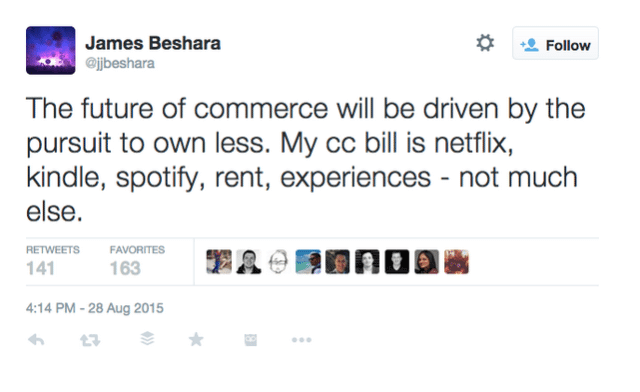 Salesforce.com is going to become the first pure Software-as-a-Service (SaaS) company to achieve a recurring revenue run rate of $10 billion dollars. And when that happens, it won’t just be a success for the SaaS model but for the entire economy. Subscriptions are the future.
Salesforce.com is going to become the first pure Software-as-a-Service (SaaS) company to achieve a recurring revenue run rate of $10 billion dollars. And when that happens, it won’t just be a success for the SaaS model but for the entire economy. Subscriptions are the future.
The global economy is making a vast, systemic shift from transactional products to subscription-based services. As Tilt cofounder James Beshara notes above, today’s consumers are interested in outcomes, not assets.
Salesforce.com helped lead this shift — now it’s inspiring dozens of industries from education to agriculture to manufacturing.
Hitting $10 billion is no easy feat, particularly for traditional companies that, revenue-wise, start every year from zero. Starting completely from scratch, the best sales team in the world would have difficulty putting together $2.5 billion every quarter.
But Salesforce.com isn’t a traditional company. It’s a subscription company, running a maniacally focused recurring revenue-based business model. Because of its business model, the question is not if it will get to $10 billion but when.
The first rule of subscriptions is to provide immediate, ongoing value to your customers.
Salesforce.com has a large and dedicated install base that, as long as customers renew, keeps paying Salesforce.com year after year. And the Salesforce.com strategy of compelling its customers to take advantage of a robust ecosystem of related services like the service cloud and third-party force.com apps generates a powerful sense of “stickiness,” which keeps those customers coming back.
I know this because I used to be the company’s Chief Strategy Officer, and I’m using many of the lessons learned at Salesforce.com to build my own subscription-based business, Zuora.
So how is Marc Benioff going to get to $10 billion? The second rule of subscriptions is that revenue is not revenue. It’s the difference between a one-time payments and recurring payments. Let’s take a look at the numbers. For this fiscal year, Salesforce.com is guiding to $6.65 billion in revenue. So it’s already two thirds of the way there. It’s on pace to hit $7 billion by the end of the year.
But remember, that revenue is recurring — it keeps coming back. That’s the beauty of subscriptions. Benioff doesn’t have to find $10 billion of completely new revenue sitting under a couch every year.
And not only that, the company’s “unbilled deferred revenue” increased 24 percent last year to $6.2 billion. So what does that mean, exactly? Unbilled deferred revenue simply represents the value of committed customer contracts that haven’t been formally billed yet. Subscription companies typically bill across year-long contracts rather than asking for huge up-front sums. This means that $6.2 billion of future revenue already in the bag isn’t even showing up on the balance sheet.
And finally, how about that profitability picture? Let’s take a look at the company’s margins in a different way. Last quarter it made $1.63 billion in revenue but spent approximately $794 million on sales and marketing. Imagine if it could turn off its sales and marketing spigot right now; its margins would increase substantially (it would cut its total operating expenses by 66 percent), but Benioff believes in the massive opportunity presented by the shift to the cloud. According to Gartner, the market for enterprise-based software, led by SaaS, will increase by 7.5 percent this year to about $150 billion. By 2019 it will represent an opportunity worth over $200 billion.
In an economy based on subscriptions, your spend on sales and marketing is going towards growing annual recurring revenue, to acquiring future revenue that is not yet in ARR. In other words, today’s sales and marketing expenses are matched to future revenue. Benioff is reinvesting his revenue in sales and marketing to get to his number faster because he realizes that he’s operating in a highly competitive landscape. Don’t expect him to turn off the spigot even when he hits $10 billion, either!
Of course, these kinds of powerful recurring metrics aren’t exclusive to Salesforce.com. The New York Times is currently benefiting from $200 million in annual recurring revenue from its 1 million digital subscribers, and Netflix blew its last earnings call out of the water, with $1.48 billion from 65 million subscribers. But software and media are just the beginning.
Even large device makers and industrial manufacturers like GM and Schneider Electric are taking advantage of recurring revenue models. The shift towards subscriptions is happening in practically every vertical, because it offers two key attributes that the investor community loves: financial stability and forward visibility.
As the CEO of a subscription-based business, I’m cheering for Benioff and his extraordinary company from the sidelines. This isn’t just a success story for Salesforce.com and the SaaS market. It’s validation of a major economic shift happening as people and businesses are acquiring the things they want and need in new ways – it’s called the Subscription Economy.